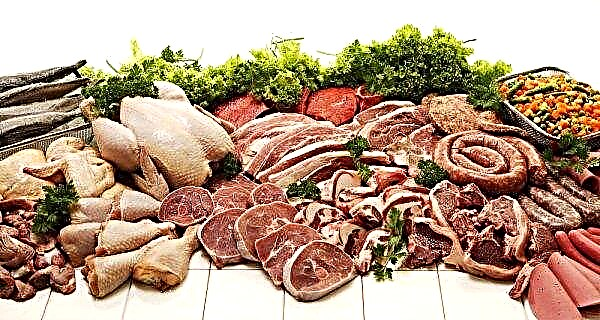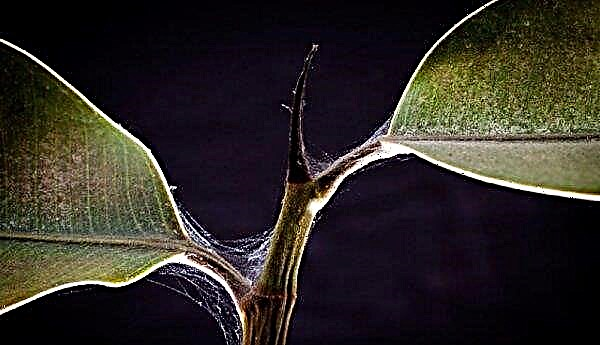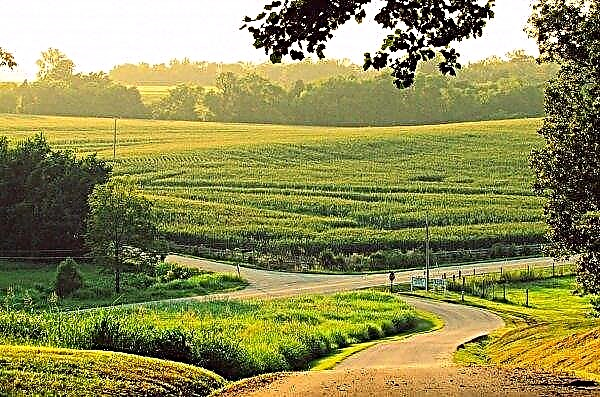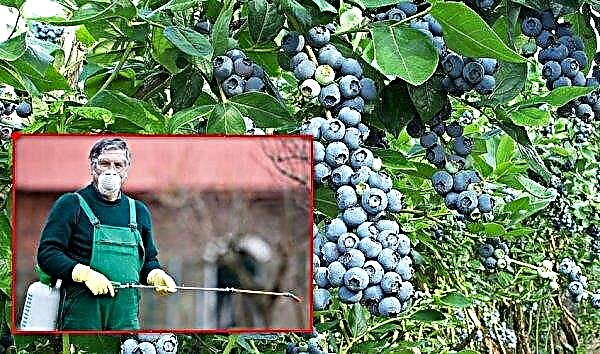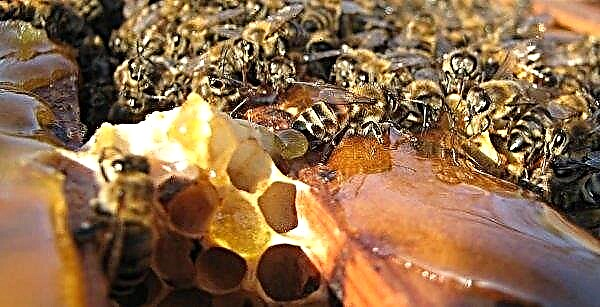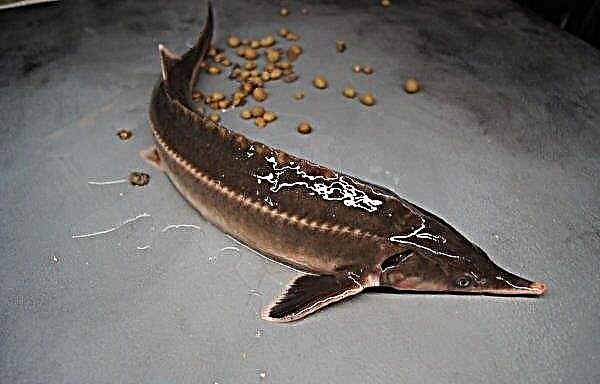Of all the materials for creating greenhouses existing on the modern market, polycarbonate is rightly considered the best option. A large selection of models that differ in shape, type of frame and other parameters allows you to use this type of polymer plastic both for equipping professional heated facilities for year-round cultivation of various cultivated plants, and for creating a small compact greenhouse in a modest summer cottage, and to collect such construction, it is not necessary to be a professional builder. This review will discuss the main types of polycarbonate greenhouses, as well as how to choose the best option for yourself and install it on your site.
Did you know? The world championship in the use of greenhouses belongs to the Netherlands. In a country with an area of only 42.5 thousand km², which is approximately 14 times smaller than the size of Ukraine, greenhouses occupy a record 10.5 thousand ha.
Types of construction
The first parameter by which all greenhouses are classified, no matter what material they are made of, is the shape. Depending on this criterion, the structures are divided into several types, but the main and most common are greenhouses with a rounded (arched) and straight (sloping) roof.
Arched
The arched type of the greenhouse suggests the presence of a frame curved in the form of an arc. It is not so simple to independently give such a shape to the material used to make the structure (profile, pipe, etc.) without special skills and tools, but still this form of the roof has a number of undeniable advantages over the corner.

- In particular, it provides:
- good tightness of the structure due to the absence of unnecessary joints;
- reliability and stability of a stationary structure due to the fact that a heavy snowdrift does not form on a sloping roof;
- longer service life (the fewer parts interconnected, the longer the greenhouse will last);
- profitability (for the same height of the greenhouse, the arched roof will require less polycarbonate consumption than two sheets joined together with an angular version);
- excellent aerodynamics (the rounded shape is always more resistant to wind gusts than angular).
Take a closer look

However, giving preference to this type of structure, it should be borne in mind that its height should not exceed 2 motherwise the framework will need to be further strengthened and strengthened, therefore greenhouses with a corner roof are more often used for growing tall plants or creating multi-tier greenhouses.
With a pitched roof (house)
Theoretically, a greenhouse can be built in the form of a conventional parallelepiped with an absolutely straight roof. If the shelter is planned to be used only during the warm season, as is usually the case with primitive film greenhouses, which are still not able to withstand the pressure of cold winter winds, this option is quite acceptable.

However, polycarbonate is an expensive material, and therefore stationary structures are prepared from it. Even if the greenhouse is not heated, and in the winter no one lives in the country, the building still remains to winter in the unassembled site. For such purposes, it is necessary to provide a sloping roof, because for all the strength of polycarbonate, the presence on the roof of a thick layer of snow, especially wet snow, is a very serious load and completely unjustified.
The second version of the polycarbonate greenhouse is a "house" with a single-pitched or gable roof, which does not allow snow to linger on its plane. Like the arched version, this type of construction is assembled without special difficulties, but at the same time, unlike the one described above, it does not require strict restrictions on the maximum permissible height.
Important! Comparing designs with an arch and corner roof, it should be noted that the second option is traditionally considered more universal.
If we talk about the advantages and disadvantages of a single-pitched and gable roof, then both options have their pros and cons. So, the presence of one slope implies a simpler design and fewer joints, which, in turn, means the presence of all the advantages that were mentioned when considering the arched greenhouse.

On the other hand, a gable roof provides better illumination of the surface, which is perhaps the most important parameter for a greenhouse. In addition, when making a construction with your own hands, it is better to give preference to the gable version, since it is much easier to draw drawings for such a greenhouse (the gable version requires serious calculations when determining the angle of inclination, if a design error is made in them, the strength of the structure can seriously suffer).
In addition to the single and double slope shape, some greenhouses provide for more complex roof structures of a polycarbonate greenhouse, suggesting the presence of additional planes located between the wall and the main slope of the roof.
Such structures look very "smart", but in fact they have more minuses than pluses, since any extra part in the structure is automatically an increase in its cost, complexity of assembly while reducing strength, reliability and durability.
Did you know? An ingenious way of arranging greenhouses was invented in Iceland. Greenhouses are placed there in the immediate vicinity of the geysers, thus providing the cultivated plants with free and absolutely environmentally friendly heating.
Wall greenhouse
Wall-mounted greenhouse is a special type of structure, the main feature of which is the absence of one wall. The greenhouse is attached directly to the house or other capital construction, which allows, on the one hand, very significant savings on materials, on the other hand, to provide the building with additional heating (not only in winter if the house is heated, but also in summer when dense walls accumulate per day a large amount of heat, and at night they begin to give it off).
The roof of a wall greenhouse can be rounded (in the form of a half-arch) or angular (single-pitched).

Among the shortcomings of the near-wall greenhouse, one can only name the lack of maneuver in choosing a place for its location. Arrangement of a garden in the immediate vicinity of a residential building is not always convenient, but in a small summer cottage this option is justified, especially if the greenhouse is designed at the same time as the house itself.
Selection of material for the frame
The second criterion, which is extremely important when choosing a model of a greenhouse, is the frame, or rather the material from which it is made.
Important! Polycarbonate does not provide structural rigidity, and therefore the entire load on the structure made from it (including wind, precipitation) lies precisely on the frame.
For the manufacture of greenhouses, wooden frames or metal strips were previously used. However, such structures are suitable only for temporary, seasonal structures: wood is a material, although durable, but not durable, and a flat metal strip is not able to withstand severe loads, so today the frame for greenhouses is made either from a profile or from a pipe, both of which can to be both metal and plastic.
Galvanized profile
The metal profile for the greenhouse frame is made of aluminum, and in addition to the usual one, it is also used anodized, or from steel - carbon, low alloy, stainless, etc.  A galvanized profile is a metal product made by pressing, molding or rolling to give it a given complex shape, designed to increase the strength of structures made from such a product.
A galvanized profile is a metal product made by pressing, molding or rolling to give it a given complex shape, designed to increase the strength of structures made from such a product.
At the same time, the main advantage of aluminum is that it practically does not rust, which is a significant advantage for a durable stationary polycarbonate greenhouse. However, this option is not cheap, if you compare it with ordinary iron or steel.
In order to save on the cost of the frame and at the same time ensure its corrosion protection, the steel must be coated with a special coating, for example, galvanized (as an alternative, polymer spraying is often used - a modern, inexpensive and well-established technology).
The shape of the profile can be different - in the form of the letters "G" (corner), "T", "P", "Z", etc. The more complex the shape and the more angles in it, the more rigid the structure will be. In the manufacture of polycarbonate greenhouses, a profile with a wall thickness of at least 1.2 mm should be used.
Trumpet
The pipe, ceteris paribus (the same material and wall thickness), is more durable than the profile, since the circular cross section is initially stronger than the angular. However, such a frame is more expensive. As was said, metal or plastic pipes are used for the manufacture of the greenhouse (the latter can be made of polypropylene, polyvinyl chloride and other polymers).

Metal is good in that it is heavy enough, which means it will provide additional stability to the entire structure. A polycarbonate greenhouse with a frame made of metal pipes is sometimes simply installed on a prepared foundation in the form of a box, without connecting the structure to the ground by means of concreting.
A lighter plastic pipe nevertheless has its advantages.
- They consist in the fact that such material:
- It is presented on the market in a huge number of different variations, allowing you to choose the best for yourself;
- it is very cheap;
- easy to assemble, which allows you to assemble any design that is called in the field (while the frame of metal pipes needs to be cooked, this requires professional skills and equipment, and therefore most often the construction must be ordered by a specialist, and then some drive a bulky structure to the site).
Did you know? The founders of the idea to deceive nature by artificial heating of plants are the ancient Romans. However, at first it looked very primitive: people just placed seedlings on special trolleys and moved them during the day, so the plants were in the sun during the day and basked in heated rooms at night.
How to equip a greenhouse
It must be said that the correct choice of the model of the greenhouse (this applies both to the form of the structure and the material from which the frame will be made) directly depends on the ultimate goal that the gardener sets himself.
Formulating this goal, it is necessary to answer for yourself a number of questions, namely:
- what plants are planned to grow;
- what size should be the structure;
- whether the greenhouse will be used all year round and, if not, whether it is supposed to be dismantled in the fall and new assembly in the spring.
The next step is the selection of the optimal location on the site. If the greenhouse will be installed in a lowland, before laying the foundation, it will be necessary to build a reliable drainage or provide a water drainage system.
Examples of improperly arranged greenhouses
Important! The greenhouse should always be placed in the most lighted place, preferably on a hill, so that excessive humidity does not damage the foundation.
An important point is the correct orientation of the structure (especially in cases where it is assumed that the planned length of the greenhouse will significantly exceed its width).
Here you must adhere to the following standard recommendations:
- summer greenhouses should be located from north to south (along the meridian), this will provide the most uniform illumination of plants inside;
- for stationary year-round greenhouses, orientation from west to east is used (in latitude), since in this case it is very important that the entire structure in winter, characterized by a short daylight, be well lit at noon when the sun is at its zenith.
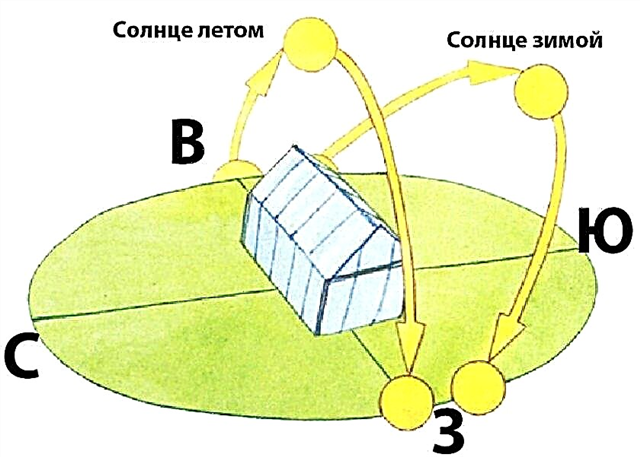
Calculation of the necessary material for the future greenhouse
When calculating the size of the future greenhouse and, accordingly, the material necessary for its construction, one should proceed from the following rules:
- The optimal microclimate is much easier to create in a small room, so sometimes it makes sense to break one bulky shelter into several more compact ones.
- Small-sized greenhouses require less rigid shelter, and the relationship between each additional square meter and the requirements for frame strength is not linear. Therefore, several small greenhouses instead of one large one can be cheaper, despite the fact that it will require more polycarbonate (due to savings on the rigidity of the frame).
- The maximum length of the greenhouse, which does not require additional strengthening and can be installed on small plots of land, should not exceed 6 m. The optimal width is 3 m and the minimum permissible - 2 m (this space will allow you to equip two beds in the greenhouse and a passage that is comfortable for processing in the middle).
- The standard height of the greenhouse is 1.8–2 m. On the one hand, this is enough for a person of average height to move normally inside, and on the other, it provides sufficient stability and reliability (higher structures require additional reinforcement).
- The length and width of the greenhouse are advised by specialists to make multiples of the standard sizes of racks that will be installed indoors. Usually they are 280 × 550 mm.
Arched greenhouse drawing example: 1 - the front side; 2 - The back side; 3 - Side view.
1 - the front side; 2 - The back side; 3 - Side view.
Guided by the above considerations, you can easily build a drawing of the future structure, and already on it to calculate the number of linear meters of the frame and polycarbonate sheets that are required for the implementation of the project.
Foundation arrangement
Depending on how overall the greenhouse is, what loads it will need to withstand and what material it has decided to use for the frame, the foundation can be:
- Monolithic platform, flooded with concrete (the heaviest option);
- Frame made of wooden boards (the easiest to perform, but minimally stable look);
- Wooden frame with concrete supports (intermediate and most common model).

In order to equip a reliable foundation for a stationary greenhouse, without resorting to concreting the entire site, you must first dig 4 holes in the corners of the territory planned for the future building to a depth of half a meter, fill in wet sand with a layer of about 80-100 mm and compact it very carefully.
Then, a frame is assembled from the boards or bars under the foundation of the future foundation, put it in place (the pits should be inside the frame) and reinforced with pillars driven into the pits, which are then either concreted or simply filled up with rubble to the top. In the first case, the greenhouse will be more stable, but the second option is more environmentally friendly, simple to execute and at the same time, if necessary, allows the structure to be moved to another place.
Installation of the greenhouse
When the foundation is ready, and all the materials necessary for equipping the greenhouse have been purchased, the final installation of the structure does not present any difficulties. For this, it is only necessary to strictly follow the instructions of the manufacturer of the goods.
Assembly usually begins with the installation of long walls, then the upper parts (arch or bevels of the roof) are connected to the sidewalls. Short walls are the last to be installed, doors and vents are attached to them with hinges).

All necessary fasteners (thermowells, self-tapping screws, clamps, etc.) are usually sold complete with polycarbonate, but you will need a screwdriver to work with them. It is also important to take care of hand protection by wearing tight fabric gloves.
Important! For the manufacture of greenhouses, it is advisable to buy polycarbonate with UV protection, since it significantly increases the durability of the material. If such protection is available, during assembly it is necessary to ensure that its layer is on the side of the sheet that will face outward.
During assembly, you should not tighten the screws very tightly, otherwise, until the structure is completely assembled, polycarbonate can be damaged. At the end of the installation, all fasteners are tightened and the joints are sealed. To do this, use a special tape that self-respecting greenhouse manufacturers include in their product packages.
Video: Assembling a polycarbonate greenhouse
A polycarbonate greenhouse is the best that a gardener can create in his personal plot or cottage, dreaming of having a stable harvest of his own vegetables and fruits. In fact, this type of greenhouse has only one drawback - its rather high cost, however, having spent it once, the owner receives a durable, reliable and high-tech construction, which is very easy to install and just as easy to maintain. But because, as they say, the game is worth the candle!



